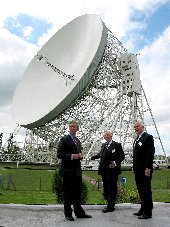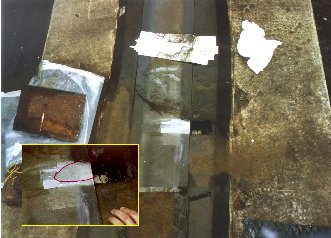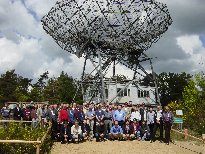
Number 5
May 2003
 |
European VLBI Network Newsletter Number 5 May 2003 |
| EVN Homepage | Publications | Meetings | User Support | Proposals | JIVE Homepage | Newsletter Archive |
Observing proposals are invited for the EVN, a VLBI network of radio telescopes in Europe and beyond operated by an international Consortium of institutes (http://www.evlbi.org). The EVN is open to all astronomers, and encourages use of the Network by astronomers not specialised in the VLBI technique. The Joint Institute for VLBI in Europe, JIVE (http://www.jive.nl), can provide support and advice on project preparation, scheduling, correlation and analysis. See htmlhttp://www.evlbi.org/support/evn_support.html.
Complete a coversheet (now available in LaTeX format) and attach a scientific justification (maximum 2 pages). Up to 2 additional pages with diagrams may be included; the total, including cover sheet, should not exceed 6 pages. See http://www.evlbi.org/proposals/prop.html. The detailed "Call for Proposals" has further information on Global VLBI, EVN+MERLIN and guidelines for proposal submission: see http://www.obs.u-bordeaux1.fr/vlbi/EVN/call-long.html. The EVN User Guide ( http://www.evlbi.org/user_guide/user_guide.html) describes the network and provides general information on its capabilities. The EVN Status Table ( http://www.oso.chalmers.se/~vlbi/EVN/EVNstatus) gives current antenna capabilities. The On-line VLBI catalogue (http://www.ira.cnr.it/~tventuri/cata.html) lists sources observed by the EVN and Global VLBI.
EVN Observing Sessions in 2003-2004
| 2003 Session 2 | May 22 - Jun 12 | 18/21cm (+ MERLIN), 6cm, 5cm, 1.3cm |
| 2003 Session 3 | Oct 23 - Nov 13 | 30 or 90cm, 18/21cm, S/X, 6cm |
| 2004 Session 1 | Feb 05 - Feb 26 | 6cm (+ MERLIN), 5cm (+MERLIN), +... |
Proposals received by 1 June 2003 will be considered for scheduling in Session 3, 2003 or later. Finalisation of the planned observing wavelengths will depend on proposal pressure. Most proposals request 12-48hrs observing time. The EVN Program Committee (PC) also encourages larger projects (>48 hrs); these will be subject to more detailed scrutiny, and the EVN PC may, in some cases, attach conditions on the release of the data. Special features for Sessions in 2003-2004;
On May 2 and 3 the EVN CBD gathered for its spring meeting at the Noto telescope in Sicily. As always an extensive agenda was laid before the Board but, for a change, there were no items of great import to be discussed. The focus of the meeting was on operational issues: the dates for VLBI sessions in 2004 were agreed; good news was reported on the dramatic improvement in throughput of the EVN data processor at JIVE - there is currently no backlog of observations awaiting correlation; less good were the problems reported in the last two sessions - some unavoidable, e.g. the Effelsberg track break, but others the result of human error. However, the dedicated staff at the observatories are working to solve the problems and overall the EVN is a vibrant and healthy organisation.
Walter Alef (Chairman of the TOG) reported on the progress on the deployment of the Mk5 systems throughout the EVN. Many of the EVN telescopes have either received or have ordered Mk5A units. It is planned to conduct a Mk5 fringe-test during the session that starts this week and, in session 3, to schedule some dual tape-disk observations in order to gain experience of the new systems.
In the previous Newsletter I mentioned that the post of Director of JIVE had been advertised. At the JIVE Board meeting that immediately followed the EVN meeting a decision on the new JIVE Director was taken. Mike Garrett, who had been Interim Director, was confirmed in the post effective May 1, 2003. I congratulate Mike on his appointment and wish him well for the future.
Finally, my two year stint as the Chairman of the EVN Board of Directors comes to an end next month. Willem Baan, Director of the WSRT at ASTRON, takes over on July 1; Franco Mantovani of the Istituto di Radioastronomia in Italy was elected as Willem's vice-chairman. I would like to thank all those who made my task easier; many have been mentioned in previous newsletters. Two who have not are Tiziana Venturi, who acts as Secretary to the EVN Board and Alastair Gunn, who has been the editor of this newsletter - both have been of immense assistance in enabling the EVN to run smoothly.
Phil Diamond (pdiamond@jb.man.ac.uk)
Chairman, CBD of the EVN
After many months of work, the University of Manchester's 76-m Lovell Telescope at Jodrell Bank Observatory (JBO) has a new, pristine surface. To commemorate the rebirth of this flagship instrument, the JBO was honoured to receive a visit, on the 28 April 2003, from His Royal Highness The Prince of Wales.

HRH The Prince of Wales meets Sir
Bernard Lovell and Professor Andrew Lyne in front of the 76-m Lovell telescope
|
After arriving, HRH was introduced to various dignitaries, including the University of Manchester's Chancellor, Ms Anna Ford and Vice-Chancellor, Professor Sir Martin Harris. He was then led on a tour of the Control Room and introduced to senior staff from the Observatory and the UK's Particle Physics and Astronomy Research Council (PPARC), including Sir Bernard Lovell, the man who instigated the telescope's creation more than 50 years ago. JBO Director, Professor Andrew Lyne then escorted HRH around the institute where he met school students involved in a science project with JBO telescopes. HRH then took a closer view of the telescope itself before meeting invited guests at the Visitor Centre. In a speech which highlighted the achievements of the telescope, HRH confessed "this is my first visit and I am thrilled to be here - although it has taken me 55 years to make it." The speech was entertaining and showed a genuine interest in the history and science of Jodrell Bank. Finally, HRH unveiled a commemorative plaque and pressed a button to initiate a move of the telescope to a pulsar, its precise ticking being broadcast over the Visitor Centre public address system.
During this summer the Lovell telescope surface will undergo a final procedure involving adjustment of over 70,000 self-tapping screws. The resulting surface accuracy will be between 1 and 2 mm, sufficient to observe efficiently up to 5 GHz and giving good gain as high as 8 GHz. The first 5 GHz EVN observations may take place in October this year.
Alastair Gunn (agg@jb.man.ac.uk)
Many EVN users scheduled for observations in the February 2003 session must have been worried to hear on 24 January that a crack had been found in the azimuth track of the Effelsberg 100-m telescope. A few days before, inspection of the track had revealed a hairline fracture in one of the welds, about 8 cm wide across the track, and azimuth driving was restricted to prevent any of the wheel-bogies from passing over the crack. Regrettably, by 28 January it was clear that at least one month would be needed for repair, and the Effelsberg telescope had to be withdrawn from the February session. After close consultation between the EVN PC Chair, Scheduler and the experiment PIs, it was decided to go ahead with just 3 user projects. Two of these (both at 22 GHz) had the 70m DSN antenna at Robledo scheduled as partial compensation for the loss of the large collecting area of Effelsberg, whilst the remaining project (a global at 8.4 GHz) was urgently required for a PhD project. Fortunately, it has proved possible to reschedule almost all the cancelled projects in the May-June session; one will be re-scheduled in October-November.

The cracked section of the Effelsberg
azimuth track with a close up of the crack (insert, circled in red). Courtesy Richard
Wielebinski.
|
The crack appeared in an evidently "unhealthy" weld after a period of very cold weather in Effelsberg (a similar event happened in 1986, forcing the postponing of observations for the author and his erstwhile student!). In fact, the entire azimuth track was replaced in 1996. The weld which gave this year was one of the thermite welds made at that time. A number of these did not pass ultra-sound testing, but the problems with this one evidently escaped detection. The current repair lasted a few weeks, and involved cutting out the cracked section, followed by normal, continuous arc welding. The telescope is now back in service, and "raring to go" for the rest of the sessions in 2003. The illustration shows an overview of the relevant section of the azimuth track, and a detail where the crack is ringed by a red circle.
Richard Porcas (porcas@mpifr-bonn.mpg.de)
The EVN recently achieved the first international Mk5-style e-VLBI fringes at 1Gbps data rate. The experiment, DT005, was a PCEVN test involving Jodrell Bank and Metsahovi Observatories at 22 GHz, which was carried out on 12 March 2003. Data were recorded using a disk-based recording system jointly manufactured by Metsahovi and Jodrell Bank. The recording system was based on the equipment developed in the PCEVN project that has proven to be extremely robust. The recording system used two computers at each station (32 tracks were recorded on each computer at 18 Mbits/sec/track). This gave 16 channels of LCP data, each with 16 MHz bandwidth and 2-bit sampling.
The quality of the data was verified immediately after the experiment using the data acquisition computers. Sampled Mk4/Mk5A data files from a water maser line source (W3OH) were Fourier transformed, and the appearance of line features at the expected frequency confirmed that the instruments had worked properly.

Fringes obtained by the EVN Correlator
at 1 Gbps using e-VLBI.
|
The data were transferred using national networks and Geant. They were correlated at the EVN MkIV Data Processor at JIVE using two Mk5A terminals. Two methods were used to transfer data: Jodrell FTP-transferred the data to a Mk5A Linux disk, Metsahovi used the File2net-Net2disk commands included in the Mk5A. Unfortunately, the data were recorded by mistake in the wrong format which the Mk5A could not play back (NRZL with parity, LSB of "rack number"=1). This was solved by software reformatting the Unix data files using simple filter programs to remove parity, zero the LSB, and recalculate the CRC of every frame header. Normally, with correct settings, PCEVN directly records Mk5A-compatible data with no need for software reformatting. At JIVE the Mk5A playback system was used and fringes were detected via the water maser (W3OH) data and thereafter the continuum radio source, 3C84. These results not only demonstrate the relative ease of performing e-VLBI, but also verify the interoperability between PCEVN and Mk5A and represent the first fringes at the EVN Correlator from data recorded at 1 Gbps.
Ari Mujunen (amn@kurp.hut.fi)
This workshop was set up to allow scientists from both the radio astronomy and network science communities to discuss the use of the Internet for data transfer in VLBI. Some 73 participants from all over the world were present. It was particularly pleasing to see scientists and engineers from national networks and VLBI astronomers from Korea, Japan and the USA at the meeting. There were 4 sessions covering the status of e-VLBI, the development of international networks, e-VLBI technology, and other projects in radio astronomy using high data rates. 22 papers and 2 posters were presented (see http://www.jive.nl/jive/evlbi_ws/meeting.html for the presentations). The meeting was organised by Steve Parsley (JIVE) and proved a great success.
Richard Schilizzi, ex-director of JIVE and now director of the Square Kilometre Array (SKA) project set the scene by discussing the development of VLBI over the last 37 years. He then pointed to the future prospect of having real time connection of VLBI telescopes to correlators, with the ability to image over the whole field of view, and with data presented to users in the form of finished images. These activities will require Gigabit connections and will make extensive use of national networks.

Participants in the 2nd e-VLBI Workshop
held in JIVE, Dwingeloo, 15-16 May 2003.
|
The progress of experiments in e-VLBI in the USA (Whitney), Japan (Kumagai), Wetzell, Germany (Kronschnabl), Finland (Ritakari), and in the Netherlands (Parsley) was described in the first session. Development of the national networks was then discussed with contributions from Fabianek (EU Commission), Radius (SURFnet), Brown (Chicago/StarLight)), de Laat (University of Amsterdam), Davies (DANTE) and Yun (Internet2). More detailed discussions of the technology followed, with talks by Hinteregger (MIT, Haystack), Mujunen (Metsahovi), Hughes-Jones (Manchester), Spencer (Jodrell Bank Observatory), Lapsley (MIT, Haystack), Uose (NTT, Japan) and Avruch (JIVE). The last session on related project had talks by McCool (Jodrell Bank Observatory) on ALMA and e-MERLIN data links, de Vos (ASTRON) on LOFAR and Durand (NRAO) on the eVLA and the New Mexico array.
Particular items to note were:
Ralph Spencer (res@jb.man.ac.uk)
In the past 35 years, VLBI images of up to a few thousand extragalactic radio sources, mostly AGN of different types, have been made with milli-arcsecond (mas) angular resolution. The combined sample of these sources is de-facto flux density limited. It represents just the tip of the iceberg in terms of the source radio luminosity. It contains low-redshift AGN with radio luminosity of 1024 W/Hz and lower. Sources of similar luminosity at higher redshifts were until recently just too weak to be imaged with VLBI.
Nowadays the improvements of VLBI instrumentation (lower noise, larger apertures, broader bands, higher stability of the signal paths) and the phase-referencing technique allow us to push the flux density limit to several orders of magnitude below the 1 Jy level. By surveying the objects in the vicinity of selected bright phase-reference calibrators (e.g. Garrington et al., 1999, NewAR, 43, 629), one could eventually build up a data base containing mas-scale radio structure data of about ten thousand or more sources. With the advent of large optical surveys, optical identifications and spectroscopic redshifts become available. The data can then be used for e.g. morphological classification, cosmological evolution, astrometric or various other studies.
To test the observing and data reduction strategies, a pilot project of the Deep Extragalactic VLBI-Optical Survey (DEVOS) has recently been completed. The original sample was selected from the unresolved sources with at least 30 mJy flux density at 1.4 GHz from the VLA FIRST survey. These objects are all within 2 degrees from the reference quasar J1257+3229, close to the north Galactic pole. As a next stage, 5-GHz MERLIN observations were conducted in March 2001 to further refine the sample, i.e. to pick up the sources that are detected at the MERLIN angular resolution and may be suitable for VLBI observations. This "target-finding" experiment led to the identification of 37 compact sources stronger than ~2 mJy out of the total of 47 FIRST-selected sources. The global 5-GHz VLBI observations involving 19 antennas of the EVN and the VLBA took place on 30 May 2002. After correlation at the EVN Data Processor at JIVE, the preliminary analysis shows a large variety of radio morphologies, ranging from those typical for compact active galactic nuclei through "classical" core-jet structures to well-resolved sources. Cross-identification of the pilot DEVOS sample with optical data from the Sloan Digital Sky Survey (SDSS) is underway. The team of co-investigators on the project were S. Frey, L. Mosoni (FOMI SGO), L. Gurvits, M. Garrett (JIVE), S. Garrington (MERLIN/VLBI NF, Jodrell Bank) and Z. Tsvetanov (Johns Hopkins University).
Sandor Frey (frey@sgo.fomi.hu)
The merging galaxy Arp 220 is among the most intensively studied extragalactic objects in the sky, and for good reason. As the prototypical luminous infrared galaxy, it exhibits extreme far infrared luminosity and a wide variety of molecular lines originating in an extremely dense central condensation of dusty gas. It is also the prototypical OH megamaser galaxy, and is the system in which parsec-scale OH megamaser features were first discovered.
In 1996, our group conducted what was then one of the largest VLBI experiments to date (prompting an NRAO press release advertising the first 20-station observation correlated by the VLBA) with Arp 220 as its target. High sensitivity continuum imaging revealed the existence of roughly a dozen unresolved sub-mJy point sources scattered across the nuclear region of the galaxy, principally in the westernmost of the two nuclei. This was interpreted as spectacular evidence of an ongoing burst of intense star formation traced by radio supernovae (RSN). Both the OH maser results (Lonsdale et al., 1998, ApJ, 493, L13) and the continuum results (Smith et al., 1998, ApJ, 493, L17) have significant implications for the field. However, these studies were severely sensitivity-limited.
In November 2002, a new VLBI experiment was conducted, which included the large dishes of the EVN, the VLBA, the phased VLA, the GBT, and Arecibo. When combined with almost conttinuous recording at a rate of 256 Mbit/sec, this experiment is one of the most sensitive VLBI observations to date. A preliminary continuum image (see Figure) boasts a rms noise level of only 8 microJy/beam, and this can be reduced by further processing to perhaps as low as 6 microJy/beam. The more than 3-fold improvement in SNR has resulted in the detection of roughly 30 RSN candidates in Arp 220, about 10 of which are found in the eastern nucleus. The brightest source in the field of view is slightly below 1 mJy.
This preliminary image constitutes dramatic evidence that intense star formation is occurring in both nuclei, and not just the western nucleus. Further data processing will reveal many more details about both the continuum and the maser emission. This work is part of an ongoing research effort by Colin Lonsdale (Haystack), Philip Diamond (JBO), Carol Lonsdale (IPAC) and Gene Smith (UCSD).
Phil Diamond (pdiamond@jb.man.ac.uk)
| The European VLBI Network (EVN) website (http://www.evlbi.org/) is hosted by the Joint Institute for VLBI in Europe (http://www.jive.nl/). |